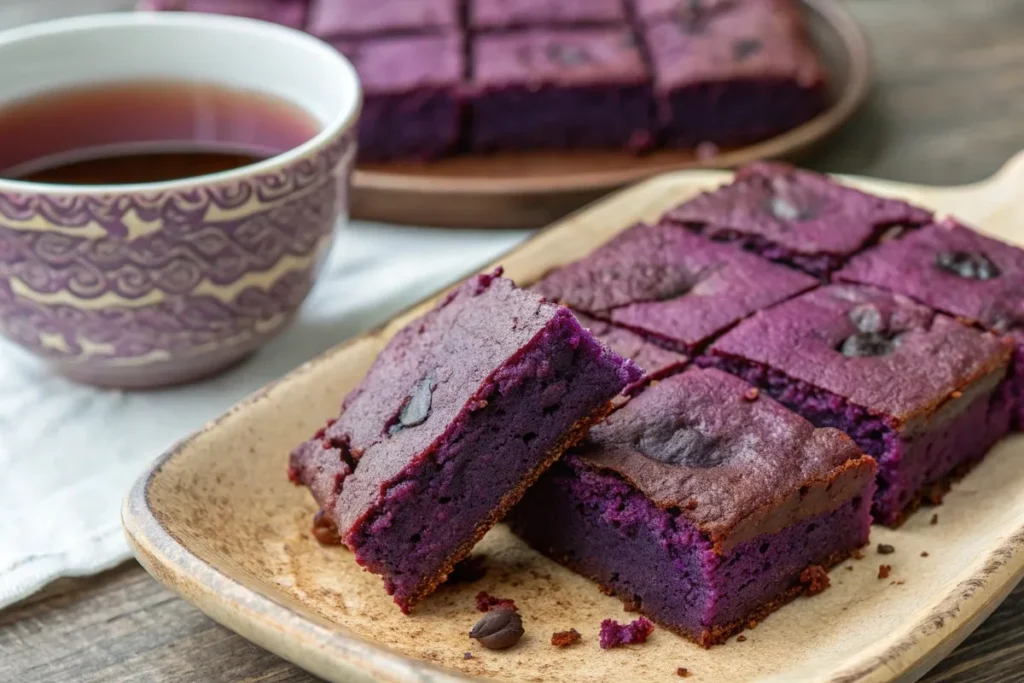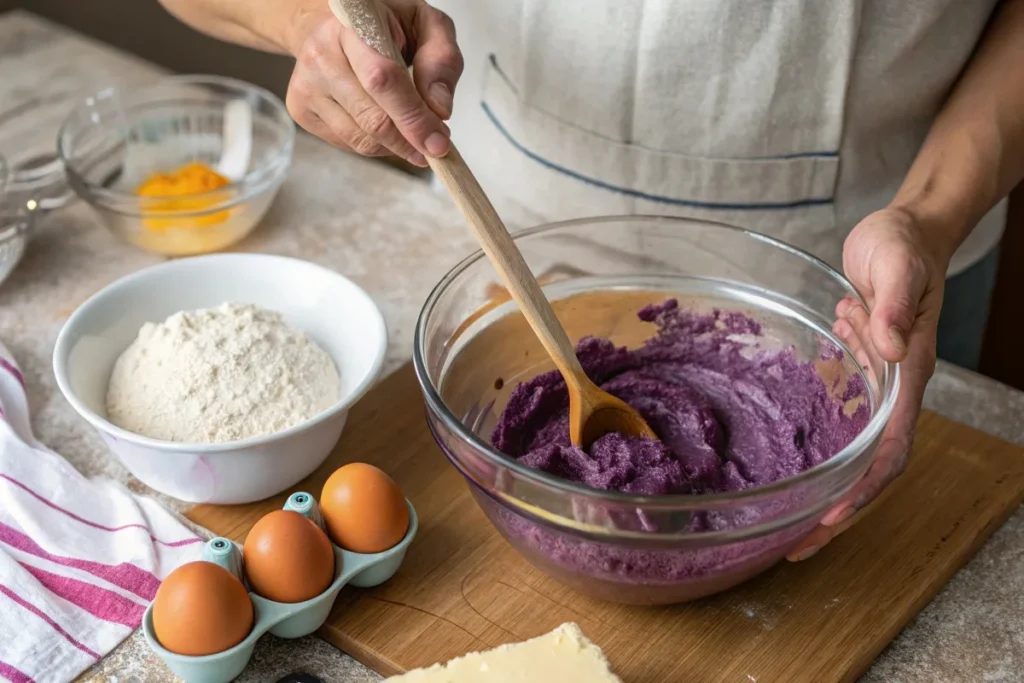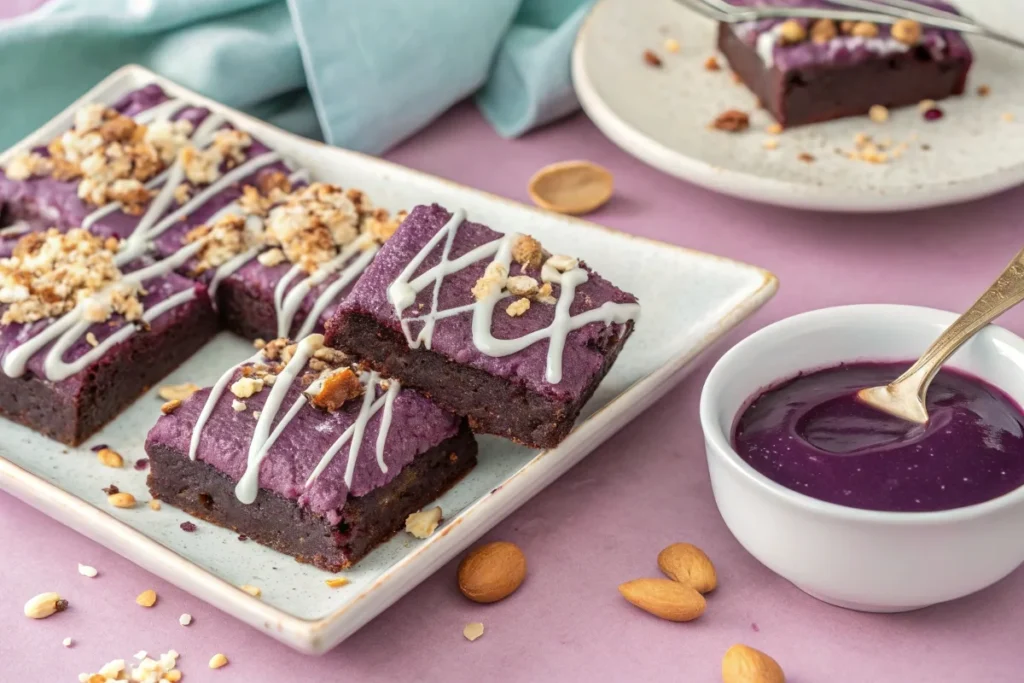Ube Brownies are the perfect way to add a colorful, flavorful twist to your classic brownie recipe! Ever feel like regular chocolate brownies are getting a little too predictable? Well, it’s time to shake things up with this vibrant, purple-hued dessert that’s as stunning as it is delicious. First, ube brings a naturally sweet, nutty flavor that pairs beautifully with the rich, fudgy texture of brownies. Plus, it’s packed with antioxidants and fiber, making these treats just a little bit healthier—because who doesn’t love a guilt-free indulgence?
Next, the best part is how easy they are to make! Whether you’re a baking pro or just starting out, you’ll love how simple this recipe is. Also, you can get creative by adding chocolate chips, coconut, or even a drizzle of white chocolate on top. Finally, imagine pulling a warm batch out of the oven, the sweet aroma filling your kitchen—irresistible, right? So, grab your mixing bowl and let’s dive in. You won’t want to miss this!
Table of contents
- What Makes Ube Brownies Unique and Irresistible
- Key Ingredients for Perfectly Moist Ube Brownies
- Step-by-Step Guide to Making Ube Brownies at Home
- Creative Variations and Toppings for Ube Brownies
- How to Store and Serve Ube Brownies for Maximum Freshness
- Frequently Asked Questions (FAQs)
- Enjoy the Sweet and Creamy Delight of Ube Brownies
What Makes Ube Brownies Unique and Irresistible
The Rich Flavor and Vibrant Color of Ube
Ube brings a one-of-a-kind taste to desserts. It has a naturally sweet, nutty flavor with hints of vanilla. This unique combination makes it stand out from traditional chocolate-based treats. Plus, its eye-catching purple color instantly makes any dessert look fun and exciting. When used in brownies, ube creates a beautiful contrast between the deep purple hue and the rich, fudgy texture. Also, unlike artificial food coloring, ube’s natural pigment adds a visual pop without extra chemicals. The best part? The flavor pairs perfectly with ingredients like coconut, white chocolate, and even cream cheese. This makes ube brownies a fantastic choice for those who love experimenting in the kitchen. So, if you want a dessert that’s as stunning as it is delicious, you’ve got to try these brownies. They’re not just tasty—they’re a feast for the eyes and the taste buds!

How Ube Enhances the Texture of Brownies
Texture is everything when it comes to brownies. Ube takes it to a whole new level. It adds extra moisture, making each bite soft, chewy, and ultra-satisfying. Unlike cocoa-based brownies, which can sometimes turn dry if overbaked, ube helps retain a naturally creamy consistency. This means every bite melts in your mouth. Another great thing about ube is how well it blends into the batter. It creates a smooth, lump-free mixture that bakes evenly. Also, because ube has a slightly starchy quality, it helps bind the ingredients together, ensuring a perfect balance between fudgy and cakey. Whether you like dense brownies or something lighter, ube delivers the best of both worlds. Once you try ube brownies, you’ll wonder why you ever settled for anything else. They’re soft, moist, and completely irresistible!
Key Ingredients for Perfectly Moist Ube Brownies
Choosing the Right Ube for the Best Taste
Not all ube is the same, so choosing the right one makes a huge difference. Fresh ube has a deep purple color and a slightly sweet, earthy taste. If you can’t find fresh ube, don’t worry—ube halaya (sweetened ube jam) or ube powder works just as well. In addition, ube extract can boost the flavor and color, making your brownies even more vibrant. Many bakers love using a combination of ube jam and extract for the perfect balance of taste and texture. Also, make sure your ube product is high quality. Some brands add artificial flavors or too much sugar, which can overpower the natural sweetness. Reading labels and choosing trusted brands will ensure you get the best results. Once you’ve got the right ube, you’re ready to bake the most delicious, moist ube brownies ever!
Essential Baking Tips for a Perfect Texture
The secret to perfect brownies lies in how you mix and bake them. First, always use room-temperature ingredients. This helps everything blend smoothly, giving you an even batter. Next, don’t overmix! Stirring too much can create a dense texture instead of a soft, chewy one. Also, using the right amount of fat, like butter or coconut oil, keeps the brownies moist. Another important tip is to line your baking pan with parchment paper. This prevents sticking and makes it easier to remove the brownies after baking. Additionally, baking at the right temperature is key. Too high, and the edges will burn while the center stays undercooked. Too low, and they won’t set properly. A good rule of thumb is to bake at 325°F to 350°F. Finally, always let your brownies cool completely before slicing. This ensures the perfect texture and makes them easier to cut!
Step-by-Step Guide to Making Ube Brownies at Home
Mixing the Ingredients for a Smooth Batter
Making ube brownies is super easy if you follow the right steps. First, gather all your ingredients, including butter, sugar, eggs, flour, and of course, ube. If you’re using ube jam, mix it with melted butter until smooth. This helps distribute the flavor evenly. Next, beat the eggs and sugar until light and fluffy. This step is important because it adds air to the batter, making the brownies soft and chewy. Then, slowly add the ube mixture to the eggs and stir gently. Also, sifting the flour before adding it prevents lumps and creates a smoother texture. Don’t forget to mix in a pinch of salt—it enhances the sweetness! Once everything is combined, pour the batter into a lined baking pan. The mixture should be thick but pourable. Now, you’re ready for the most exciting part—baking!

Baking Techniques for Evenly Cooked Brownies
Baking ube brownies perfectly takes a little patience, but it’s worth it. First, preheat your oven to 350°F. This ensures even cooking from the start. Then, place your brownie pan in the center of the oven. This prevents the edges from baking too fast while the middle stays raw. Also, avoid opening the oven door too often. Sudden temperature changes can cause the brownies to sink in the middle. Next, use the toothpick test! Insert a toothpick into the center—if it comes out with moist crumbs (not wet batter), they’re done. Additionally, letting them rest after baking is just as important. Cooling allows the flavors to develop and makes slicing easier. Finally, cut into squares and enjoy! The result? Perfectly baked ube brownies with a soft, fudgy texture.
Creative Variations and Toppings for Ube Brownies
Adding Nuts, Chocolate, and Other Flavors
Want to take your ube brownies to the next level? Add some mix-ins! Nuts like walnuts, pecans, or almonds add a delicious crunch. They also balance the sweetness, making every bite more exciting. If you’re a chocolate lover, try adding white chocolate chips. Their creamy sweetness pairs perfectly with the nutty flavor of ube. Also, shredded coconut is a great option! It enhances the tropical vibe and adds extra chewiness. Another fun idea is to swirl in a layer of cream cheese before baking. This creates a beautiful marbled effect and adds a tangy contrast to the sweetness. No matter what you choose, adding mix-ins makes your brownies even more irresistible.

Frosting and Drizzle Ideas for Extra Indulgence
Toppings can take your ube brownies from delicious to absolutely decadent! First, try a simple white chocolate drizzle. The sweetness complements the ube flavor beautifully. Next, a rich cream cheese frosting adds a tangy, velvety texture. Also, a dusting of powdered sugar is a great option for a simple, elegant look. Want something fun? Sprinkle crushed graham crackers or toasted coconut on top! These add extra texture and flavor. Finally, for a bakery-style finish, top your brownies with whipped cream and fresh fruit.
How to Store and Serve Ube Brownies for Maximum Freshness
Proper Storage Methods to Keep Brownies Moist
Keeping your ube brownies fresh is easy if you store them the right way. First, always let them cool completely before storing. Warm brownies can trap moisture, making them soggy. Next, place them in an airtight container. This prevents them from drying out. Also, if you plan to eat them within a few days, keep them at room temperature. For longer storage, refrigerate them—they’ll stay fresh for up to a week. Additionally, you can freeze them! Wrap individual slices in plastic wrap, then store them in a freezer bag. When you’re ready to eat, just let them thaw or warm them up for a few seconds in the microwave.
The Best Ways to Present and Enjoy Ube Brownies
Serving ube brownies is just as fun as baking them! First, cut them into neat squares for a classic look. Next, pair them with a scoop of vanilla ice cream for a creamy contrast. Also, serving them with hot coffee or tea makes for a perfect afternoon treat. If you’re feeling fancy, drizzle caramel or white chocolate on top for extra sweetness. Additionally, stacking brownies with whipped cream between layers creates a beautiful dessert tower. Whether you’re enjoying them as a quick snack or at a party, ube brownies always steal the show!
Frequently Asked Questions (FAQs)
What do ube brownies taste like?
Ube brownies have a sweet, nutty flavor with hints of vanilla. They taste rich and creamy but not overly sugary. The natural sweetness of ube blends beautifully with the buttery, fudgy texture of brownies. Also, they have a slightly earthy undertone, making them different from regular chocolate brownies. If you love sweet potatoes or taro, you’ll enjoy the unique taste of ube. Plus, their vibrant purple color makes them extra fun to eat! Each bite is soft, moist, and packed with flavor. Once you try ube brownies, you’ll want to bake them again and again!
What flavors go well with ube?
Ube pairs well with many flavors! First, coconut enhances its natural sweetness and adds a tropical touch. Next, vanilla brings out its warm, creamy notes. Also, white chocolate complements ube’s nutty taste without overpowering it. Additionally, cream cheese adds a tangy contrast that balances the sweetness. Want something extra indulgent? Try pairing ube with caramel or condensed milk for a rich, melt-in-your-mouth treat. Even coffee works well, adding a deep, roasted flavor. No matter how you mix it, ube is super versatile and pairs beautifully with many different flavors!
Do ube and dark chocolate go together?
Yes! Ube and dark chocolate make an amazing combination. The deep, slightly bitter taste of dark chocolate balances the sweet, nutty flavor of ube. Together, they create a rich, complex dessert that isn’t too sugary. Also, dark chocolate enhances the creamy texture of ube brownies, making each bite even more satisfying. If you love bold flavors, adding dark chocolate chips or a drizzle of melted chocolate is a great idea. Plus, the contrast between dark chocolate and ube’s vibrant purple color makes desserts look as good as they taste!
What is ube flavoring used for?
Ube flavoring is used to enhance the taste and color of desserts. First, it’s popular in cakes, ice cream, and pastries. Also, many people use it in milkshakes, lattes, and even pancakes. In addition, ube flavoring makes homemade ube brownies even more vibrant and flavorful. It’s perfect for when fresh ube isn’t available. Plus, just a few drops can transform any dessert into a delicious ube-flavored treat! Whether you’re baking, making drinks, or experimenting in the kitchen, ube flavoring is a great way to add that signature taste and beautiful purple color.
Enjoy the Sweet and Creamy Delight of Ube Brownies
Ube brownies are the perfect treat for anyone who loves sweet, rich, and colorful desserts. Their nutty, vanilla-like flavor and soft, fudgy texture make them completely irresistible. Also, they’re fun to make and easy to customize with toppings like chocolate, coconut, or cream cheese. Next, whether you enjoy them warm with ice cream or as a quick snack, they’re always a crowd-pleaser. In addition, they store well, so you can enjoy them for days. If you haven’t tried ube brownies yet, now is the time! So grab your ingredients, start baking, and enjoy every delicious bite.
